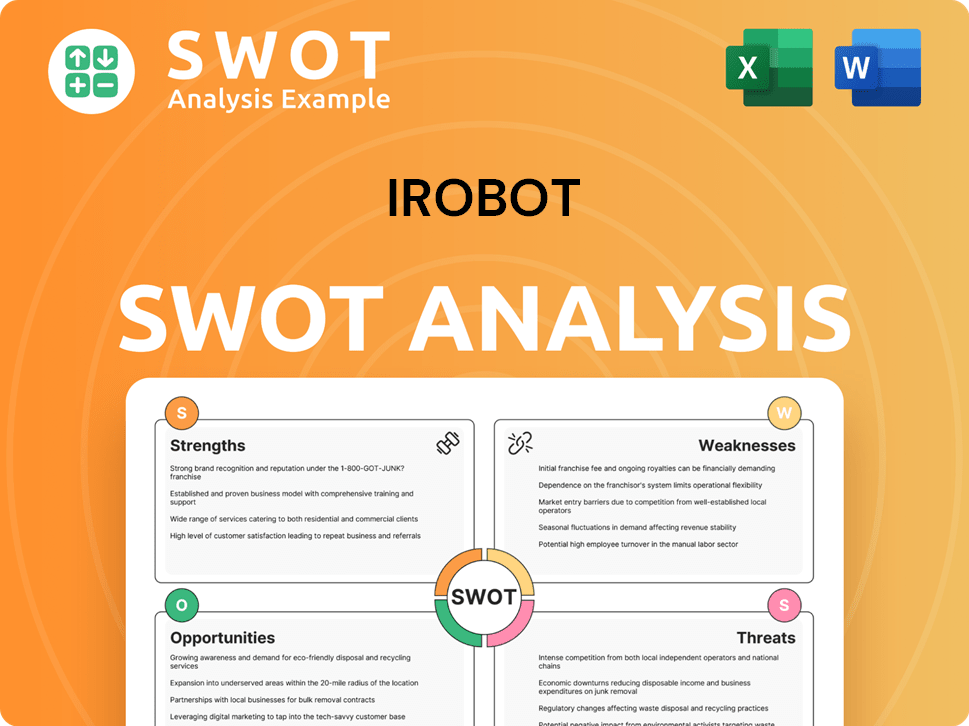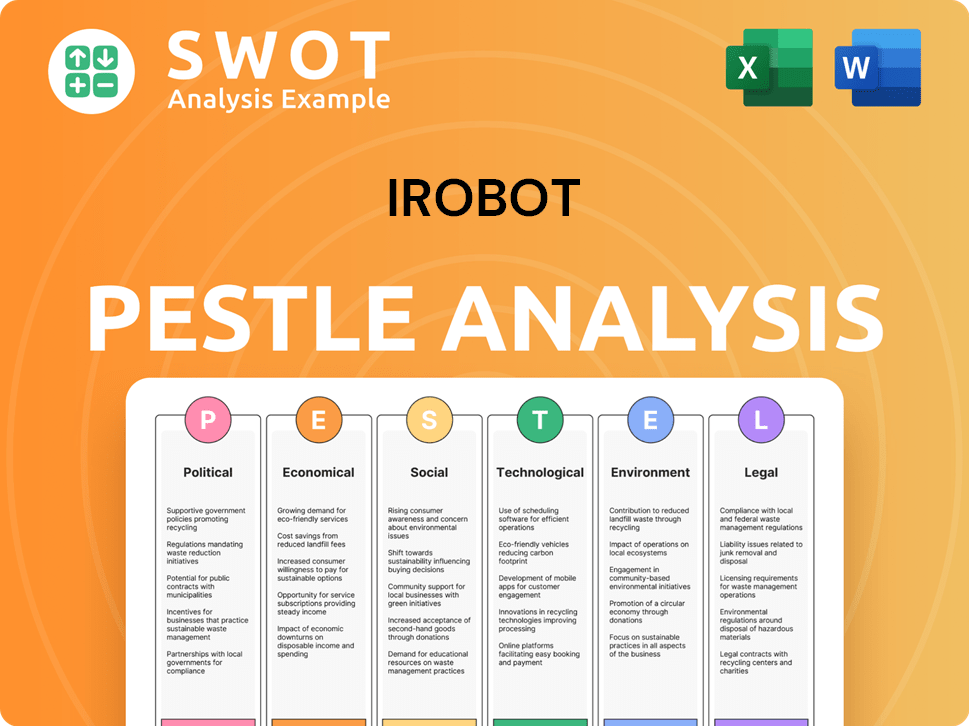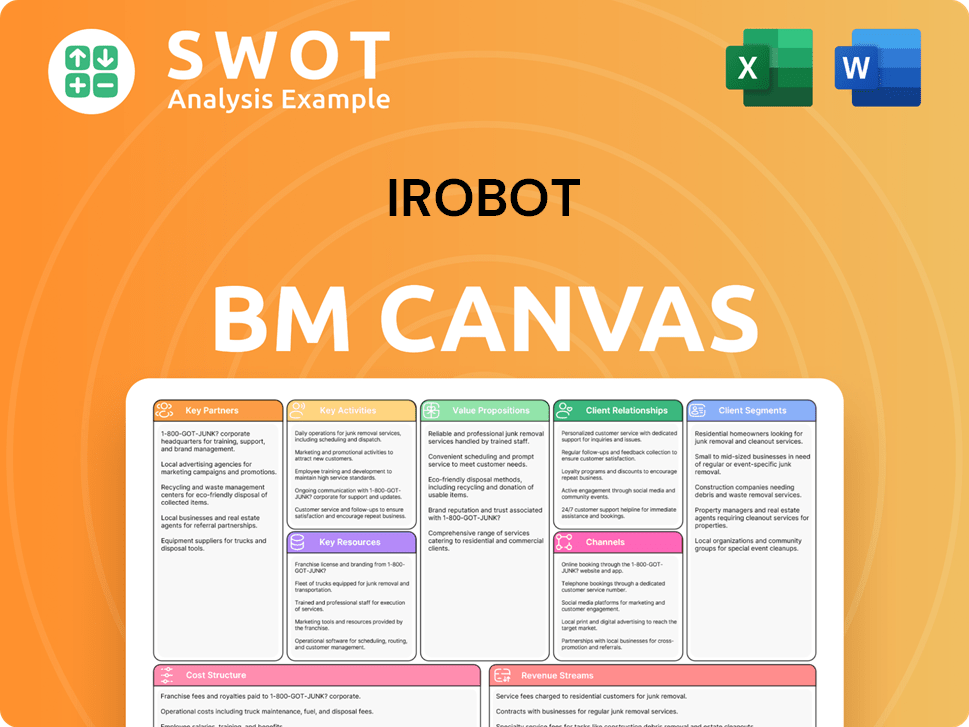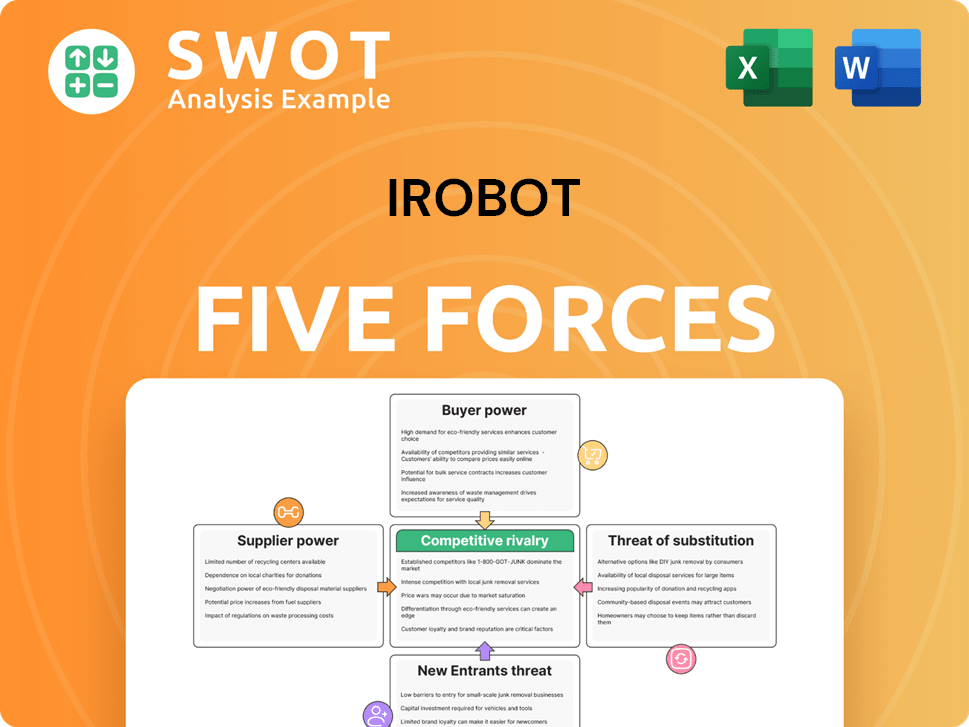iRobot Bundle
Can iRobot Reclaim Its Throne in the Robotic Vacuum Market?
iRobot, the pioneer behind the iconic Roomba, has revolutionized home cleaning with its innovative robotic vacuums. From its roots in space exploration and military applications, iRobot has become a household name, selling millions of units worldwide. However, the iRobot SWOT Analysis reveals a company now facing intense competition and strategic challenges.

This analysis delves into the iRobot competitive landscape, exploring its key iRobot competitors and the dynamics of the robot vacuum market. We will examine iRobot's market share 2024, its strengths and weaknesses, and how it stacks up against rivals like Shark and Ecovacs. Understanding iRobot's strategic partnerships and its future in the robotics market is crucial in this rapidly evolving industry.
Where Does iRobot’ Stand in the Current Market?
iRobot holds a strong position in the home robotics market, particularly in the robot vacuum segment. The company is known for its Roomba vacuum cleaners and Braava robot mops, which cater to a wide customer base. These include homeowners seeking convenient cleaning solutions, busy professionals, and tech enthusiasts interested in advanced AI robots. iRobot's success is built on its innovation in the robotics industry and its ability to provide user-friendly products.
iRobot distributes its products through multiple channels, including its website and partnerships with online and offline retailers. This multi-channel strategy helps iRobot reach a broad audience and maintain a significant market presence. The company's global operations are also a key factor, with a substantial portion of its revenue coming from outside the United States. For more insights, you can explore a brief history of iRobot.
Despite its market leadership, iRobot faces challenges and competition. The company's financial performance in 2024 reflects these pressures, with a decrease in revenue and profitability. The competitive landscape includes various players, and iRobot must navigate these challenges to maintain its market position and drive future growth.
iRobot has a strong presence in the United States and globally. Non-U.S. sales accounted for 51.2% of total revenue in fiscal year 2024. However, the company experienced significant revenue decreases in Q4 2024 across the U.S. (47%), Japan (34%), and EMEA (44%) compared to the prior year.
Total revenue for 2024 was $681.8 million, a 23.4% decrease from $890.6 million in 2023. The GAAP gross margin for 2024 was 20.9%, down from 22.0% in 2023. iRobot reported a GAAP net loss of $145.5 million for 2024, an improvement from a $304.7 million net loss in 2023.
iRobot has significantly reduced its headcount by over 50% since January 2024 as part of its operational restructuring. As of December 28, 2024, the company had cash and cash equivalents totaling $134.3 million. iRobot has issued a warning about 'substantial doubt' regarding its ability to continue as a going concern.
iRobot's products are sold through multiple channels, including its official website and partnerships with online and offline retail chains. This multi-channel strategy helps the company reach a broad customer base. The company's global operations are a key factor, with a substantial portion of its revenue coming from outside the United States.
iRobot's competitive landscape is affected by its market position, financial performance, and strategic decisions. The company's revenue and profitability have been impacted by market conditions and competition. The restructuring efforts and financial warnings highlight the challenges iRobot faces.
- Revenue decline of 23.4% in 2024.
- Net loss of $145.5 million in 2024, improved from 2023.
- Significant headcount reduction as part of restructuring.
- Warning about the ability to continue as a going concern.
iRobot SWOT Analysis
- Complete SWOT Breakdown
- Fully Customizable
- Editable in Excel & Word
- Professional Formatting
- Investor-Ready Format

Who Are the Main Competitors Challenging iRobot?
The iRobot competitive landscape is intensely contested, with numerous companies vying for market share in the robotic vacuum cleaner sector. The market analysis reveals a dynamic environment where established players and emerging competitors continually reshape the industry. The company faces significant challenges from both direct rivals and companies expanding into home robotics.
Key direct competitors include Ecovacs Robotics, Neato Robotics, Samsung Electronics, SharkNinja, and Xiaomi, all offering home cleaning robots. These companies actively compete for market share, impacting the company's position. The robot vacuum market is also influenced by broader consumer electronics and appliance companies.
Beyond direct competitors, the broader competitive landscape includes consumer electronics and appliance companies like Cecotec, Dreame, Electrolux, LG, Midea, Roborock, Bissell, Dyson, and Hoover, many of whom have introduced their own robotic offerings. New market entrants and aggressive pricing strategies, particularly from Asian competitors, exert pressure on the company's profit margins.
Direct competitors include Ecovacs Robotics, Neato Robotics, Samsung Electronics, SharkNinja, and Xiaomi, all offering robotic vacuum cleaners. These companies actively compete for market share, impacting the company's position. Xiaomi's vacuums are known for their performance, mapping, and competitive pricing.
The competitive landscape extends to consumer electronics and appliance companies like Cecotec, Dreame, Electrolux, LG, Midea, Roborock, Bissell, Dyson, and Hoover. Many of these companies have introduced their own robotic offerings, increasing the competition. This broader competition puts pressure on the company's market share.
Market dynamics are influenced by innovation, branding, distribution, and technology. Chinese robotic vacuum cleaner producers have been gaining market share globally. Regulatory concerns, such as those highlighted by the failed Amazon acquisition, also impact the competitive landscape.
Aggressive pricing strategies from competitors, especially those from Asia, put pressure on profit margins. Chinese robotic vacuum cleaner producers held 68% and 55% of the category in Southeast Asia and Europe, respectively, as of November 2023. This demonstrates the impact of competitive pricing and market penetration.
Innovation in areas like cleaning performance, intelligent mapping, and smart home integration is crucial for competitiveness. The company must continually innovate to stay ahead of rivals. Smart home integration and advanced features are key differentiators in the market.
Mergers and alliances, such as the attempted acquisition, impact competitive dynamics. The failure of the Amazon deal in January 2024 highlighted regulatory concerns. Strategic partnerships and acquisitions can significantly alter the competitive landscape.
Several factors influence the competitive dynamics in the robotics industry. Understanding these factors is crucial for assessing the company's position and future prospects. The company's ability to navigate these factors will determine its success in the market.
- Pricing: Competitive pricing strategies are essential to attract cost-conscious consumers.
- Innovation: Continuous innovation in cleaning technology and features is vital.
- Branding: Strong brand recognition and consumer trust are significant advantages.
- Distribution: Effective distribution channels are necessary to reach a wide customer base.
- Technology: Advanced technology, including mapping and smart home integration, is crucial.
For more in-depth information, you can explore the financial performance of the company and its competitors, as well as other aspects of the business, by reading Owners & Shareholders of iRobot.
iRobot PESTLE Analysis
- Covers All 6 PESTLE Categories
- No Research Needed – Save Hours of Work
- Built by Experts, Trusted by Consultants
- Instant Download, Ready to Use
- 100% Editable, Fully Customizable

What Gives iRobot a Competitive Edge Over Its Rivals?
The iRobot competitive landscape is shaped by its innovative technology, strong brand recognition, and strategic partnerships. The company, a key player in the robotics industry, faces competition from various companies in the home robotics and robot vacuum market. Understanding iRobot's competitive advantages is crucial for analyzing its market position and future prospects. The company's ability to innovate and adapt to market changes is a key factor in its success.
iRobot's strengths lie in its proprietary technology, extensive patent portfolio, and continuous product development. These factors enable it to stay ahead of its rivals and maintain a competitive edge. The company's financial performance and market share are influenced by its ability to differentiate itself through innovation and strategic partnerships. The competitive landscape includes rivals like Ecovacs and Shark, which compete with iRobot's Roomba and Braava products. iRobot's ability to navigate this competitive environment is essential for its long-term success.
The company's focus on research and development, along with its strategic initiatives to reduce product costs and increase innovation, are vital for sustaining its competitive position. The home robotics market is dynamic, and iRobot's ability to adapt to changing consumer preferences and technological advancements will be critical. For a deeper dive into the company's growth strategies, consider reading about the Growth Strategy of iRobot.
iRobot's cutting-edge, behavior-based AI robots and advanced algorithms are core to its competitive advantage. The company invests heavily in R&D to develop advanced AI and sensors. This enables their robots to navigate complex environments efficiently, setting them apart in the robot vacuum market.
The Roomba brand is synonymous with robotic vacuum cleaners, fostering customer trust and loyalty. This strong brand equity contributes to repeat purchases and a solid market position. iRobot's reputation for reliability and innovation is a key differentiator.
iRobot offers a diverse product portfolio, including vacuum cleaners and robotic mops (Braava), catering to various customer needs. This expands its market reach and allows it to compete effectively in the home robotics sector. The company's product range helps it maintain a strong position against competitors.
iRobot leverages strategic partnerships with retailers, distributors, and technology companies to expand its market reach. Collaborations with companies like Amazon and Google enhance product offerings and provide additional value. These partnerships are crucial for iRobot's competitive position.
iRobot's competitive edge is built on several key factors that differentiate it from rivals. These advantages include technological innovation, brand recognition, a diverse product portfolio, and strategic partnerships. The company's ability to continuously innovate and adapt to market changes is critical for its long-term success.
- Proprietary Technology: iRobot's focus on proprietary technology and a robust patent portfolio is key.
- Product Development: Continuous product development and strategic initiatives to reduce costs.
- Market Position: iRobot's strong brand recognition and diverse product offerings.
- Strategic Alliances: Partnerships with major retailers and technology companies.
iRobot Business Model Canvas
- Complete 9-Block Business Model Canvas
- Effortlessly Communicate Your Business Strategy
- Investor-Ready BMC Format
- 100% Editable and Customizable
- Clear and Structured Layout

What Industry Trends Are Reshaping iRobot’s Competitive Landscape?
The iRobot competitive landscape is significantly influenced by industry trends, future challenges, and strategic opportunities. The company faces a dynamic market shaped by technological advancements, shifting consumer preferences, and global economic factors. Understanding these elements is crucial for assessing iRobot's market analysis and its ability to compete within the robotics industry.
iRobot's position is currently marked by both challenges and opportunities. The company is navigating a competitive environment, with financial performance under scrutiny. However, strategic initiatives and product innovation offer potential pathways for growth and market share expansion in the home robotics sector. The company's ability to adapt to industry changes will be key to its future success.
The robot vacuum market is experiencing increased demand for smart home solutions and connected devices. Advancements in AI, machine learning, and IoT are driving innovation in cleaning robots. Sustainability is also becoming a key focus, with consumers looking for eco-friendly and energy-efficient products.
The market is highly competitive, with pricing pressures from established and new entrants. Regulatory changes, especially concerning data privacy and tariffs, pose ongoing risks. iRobot's financial health is a concern, with a net loss of $77.1 million reported in Q4 2024 and a significant revenue decrease to $172.0 million.
iRobot is focusing on product innovation, strategic partnerships, and international expansion. The company aims to return to year-over-year revenue growth in 2025 with new product launches. Expansion into new markets, such as commercial cleaning, healthcare, and security, presents further growth potential.
The 'iRobot Elevate' strategy is central to the company's plans for growth. The company is exploring a potential sale or strategic transaction to improve liquidity. Furthermore, the company is focused on margin-accretive product development and a lower cost structure.
The competitive landscape includes several iRobot competitors, with pricing strategies impacting profit margins. The company is also dealing with challenges in the market, as highlighted in Growth Strategy of iRobot. The company is focused on strategic initiatives to return to revenue growth.
- iRobot's Q4 2024 revenue was $172.0 million, a decrease from the previous year.
- New products, such as the Roomba Plus 405 Combo Robot + AutoWash Dock and Roomba Plus 505 Combo Robot + AutoWash Dock, are designed to improve margins.
- The company is exploring expansion into new markets beyond consumer robotics.
- The company's strategic review includes evaluating refinancing debt and exploring a potential sale or strategic transaction.
iRobot Porter's Five Forces Analysis
- Covers All 5 Competitive Forces in Detail
- Structured for Consultants, Students, and Founders
- 100% Editable in Microsoft Word & Excel
- Instant Digital Download – Use Immediately
- Compatible with Mac & PC – Fully Unlocked

Related Blogs
- What are Mission Vision & Core Values of iRobot Company?
- What is Growth Strategy and Future Prospects of iRobot Company?
- How Does iRobot Company Work?
- What is Sales and Marketing Strategy of iRobot Company?
- What is Brief History of iRobot Company?
- Who Owns iRobot Company?
- What is Customer Demographics and Target Market of iRobot Company?
Disclaimer
All information, articles, and product details provided on this website are for general informational and educational purposes only. We do not claim any ownership over, nor do we intend to infringe upon, any trademarks, copyrights, logos, brand names, or other intellectual property mentioned or depicted on this site. Such intellectual property remains the property of its respective owners, and any references here are made solely for identification or informational purposes, without implying any affiliation, endorsement, or partnership.
We make no representations or warranties, express or implied, regarding the accuracy, completeness, or suitability of any content or products presented. Nothing on this website should be construed as legal, tax, investment, financial, medical, or other professional advice. In addition, no part of this site—including articles or product references—constitutes a solicitation, recommendation, endorsement, advertisement, or offer to buy or sell any securities, franchises, or other financial instruments, particularly in jurisdictions where such activity would be unlawful.
All content is of a general nature and may not address the specific circumstances of any individual or entity. It is not a substitute for professional advice or services. Any actions you take based on the information provided here are strictly at your own risk. You accept full responsibility for any decisions or outcomes arising from your use of this website and agree to release us from any liability in connection with your use of, or reliance upon, the content or products found herein.